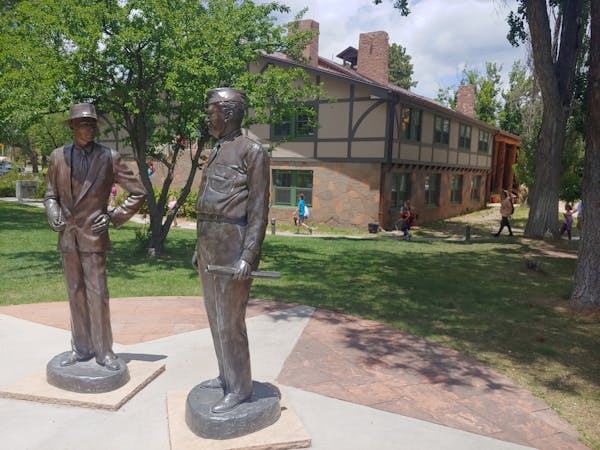Some states get all the hype, especially when it comes to national parks. Yes, California is home to nine national parks — the most in the nation — including well-heralded gems such as Death Valley, Yosemite and Joshua Tree. And Arizona is famed for its Saguaro, Petrified Forest and Grand Canyon national parks.
Yet many people are surprised to learn that New Mexico cradles 15 National Park Service sites within its borders, including two national parks and a whopping nine national monuments, the third-highest concentration in the U.S. These sites are sprinkled throughout the state, so you're never too far from one, no matter where you're traveling.
Here are some of New Mexico's more notable national treasures, along with tips for making the most of your exploration.
White Sands National Park
White Sands in southern New Mexico is home to the world's largest gypsum dune field. Picture an otherworldly landscape, where undulating mounds of snowy white crystals stretch to the horizon, sparkling and shape-shifting with the wind.
People flock here to drink in this indescribable scenery while hiking along the dunes on one of the park's five trails. Sledding down the dunes on colorful waxed, plastic saucers is another popular activity, as is backcountry camping. (The backcountry campsites are currently closed for rehabilitation.)
The park is adjacent to the U.S. Army's White Sands Missile Range. The range includes the Trinity Site, where U.S. scientists detonated the world's first nuclear weapon in 1945, as depicted in "Oppenheimer." The Trinity Site typically opens to the public twice a year, but April's "open house" was canceled; the next scheduled event is on Oct. 19.
Tips: Always carry plenty of water, especially when hiking on the dunes. Plan to stay at the park until sunset, when the setting sun often dresses the sands in fanciful colors, such as tangerine, pink and lavender. The park also offers guided sunset and full moon night hikes.
Bandelier National Monument
Nearly 1,000 years ago, the Ancestral Pueblo people lived in homes they'd carved into the soft, rocky cliffs in the landscape north of Santa Fe, protected today as part of Bandelier National Monument. You can visit these unique homes by hiking along some of the monument's 70-plus miles of trails. Two popular stops are Alcove House and Upper Falls.
Access Alcove House by taking a spur off the Pueblo Loop Trail, the monument's main path. Along the way you'll be able to peer into numerous cliff dwellings. Alcove House, which once housed two dozen residents, sits 140 feet above the floor of Frijoles Canyon. To view the residence, you'll need to climb four wooden ladders and some stone steps. The home contains a reconstructed kiva, a large, circular room once used for spiritual ceremonies, among other treasures.
Take the Falls Trail, which unspools 400 vertical feet downward, to view Upper Falls, which can be magnificent during spring snowmelt. The trail also showcases impressive volcanic remains.
Tips: There are only a few miles of paved road in the park. Starting mid-May, you'll need to take a shuttle bus from White Rock Visitor Center to access some of the monument's more popular spots. Consider arriving as soon as the park opens, especially during warm weather, to beat the heat and avoid the lines that often form where there are ladders to climb along the trail.
Gila Cliff Dwellings National Monument
Like Bandelier, the Gila Cliff Dwellings showcase homes carved into rocky cliffs, inhabited in this case by the agricultural Mogollon people from about 1270 to 1300. Scientists believe they chose to live here to escape a 30-year drought that affected the area. (A year-round stream flows beneath the caves.) Earlier hunter-gatherers used the caves for thousands of years as part of their seasonal migration.
Unlike Bandelier, this national monument is small, with a single, one-mile trail looping past the cliff dwellings. You can climb a wooden ladder and walk inside several of the living areas, which is a rare perk. A visitor center offers some interpretive displays.
Tips: There are several campgrounds and hiking trails just outside of the monument. A few piggyback onto the famous Continental Divide National Scenic Trail. One especially pretty trek is the seven-mile (one way) hike from Little Bear Canyon to Jordan Hot Springs. It involves crossing the typically shallow Gila River 15 times.
El Malpais National Monument
If you enjoy exploring volcanic landscapes, head to El Malpais. The expansive monument was previously covered by five major lava flows and features massive lava fields, lava tube caves and cinder cones. But there's a lot more than dark, barren landscapes here.
The monument is also filled with dramatic sandstone formations, including the famous La Ventana Arch, one of New Mexico's largest sandstone arches. You can view some of these formations from your car — two paved highways follow the park's eastern and northwestern borders — or on foot.
Hiking trails abound, including the popular path to the Narrows Rim. A trek along this 4.5-mile (one way) trail showcases lava flows and beds, and ends at a point offering dramatic vistas, including one featuring La Ventana. The Continental Divide National Scenic Trail also runs through this monument's acreage.
Tips: Take along plenty of water, especially if you're hiking in summertime. During the summer, thunderstorms accompanied by lightning often develop quickly, so head back if one occurs. The altitude on the Narrows Rim tops 7,000 feet, so allow plenty of time for your trek if you're not acclimated to the altitude.
Melanie Radzicki McManus is a travel and adventure writer who lives near Madison, Wis.

The 5 best things our food writers ate this week

A Minnesota field guide to snow shovels: Which one's best?

Summer Camp Guide: Find your best ones here

Lowertown St. Paul losing another restaurant as Dark Horse announces closing





